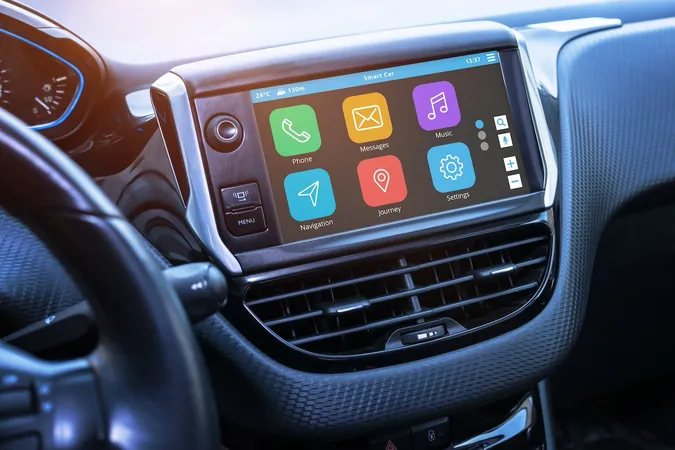
Are Vehicle Infotainment Screens on Their Last Legs? The Future Is Not What You Think!
2025-03-29
Author: Chun
In the modern automotive landscape, cars are advancing at a breathtaking pace, boasting technology that was once unimaginable. However, amid this progress, some innovations have become more burdensome than beneficial. The spotlight is now on infotainment screens—a feature that many drivers are starting to question.
Initially, touch screens and large displays gained popularity for their sleek design, allowing users to interact with their vehicles similar to how they would with smartphones. But the reality has proven less glamorous. Flaws in these systems are prompting a backlash from drivers who feel overwhelmed rather than empowered.
Infotainment screens made their debut years ago, gaining significant traction when Tesla introduced iPad-like controls in the mid-2010s. Presently, approximately 97% of new cars are outfitted with a touch screen, and around 25% feature screens measuring 11 inches or larger. Automakers have been enthusiastic about embedding newer functionalities, ranging from accessing messaging apps and streaming services to consolidating all vehicle controls into these screens—often hidden behind complex menus.
Tech giants like Apple and Google have ambitious plans for these digital dashboards, but delays, particularly from Apple regarding its CarPlay upgrade, have cast uncertainty on the future direction of infotainment systems. Google has stepped in as the primary software provider, yet consumer demand seems to be leveling off. A recent study revealed that only 15% of drivers in 2024 desire a full-width infotainment display, while slightly more prefer simpler windshield displays—showing that less complexity could be more desirable.
The growing dissatisfaction stems from significant safety and usability concerns. Although having controls consolidated in one location seems convenient, navigating multiple menus while driving can be both distracting and unsafe. Basic functions are often subject to glitches and software lag, underscoring a reliance on technology that can falter. For example, a 2021 Tesla recall due to malfunctioning infotainment systems disrupted vital features, including visibility for the rearview camera and turn signals. More recently, a class-action lawsuit against Stellantis highlights failures linked to infotainment screens resulting in backup camera issues and distracting audio glitches.
Addressing these issues, some automakers have begun to pivot away from their reliance on touch screens. Volkswagen, for instance, announced a return to physical buttons after consumers expressed frustration with their touch-centric designs. CEO Thomas Schäfer admitted that their focus on screens had "damaged" the brand's reputation. Consumer reviews were scathing, with many critics dubbing VW's system as one of the worst in the industry.
As manufacturers respond to this consumer pushback, the path forward remains unclear. Some have adopted innovative designs that blend technology with user-centric features. At CES 2025, BMW unveiled a cutting-edge heads-up display (HUD) that allows drivers to choose what information they want in their line of sight while driving. This development aims to provide customization without taking focus off the road. Moreover, drivers can adjust settings using physical buttons on the steering wheel, allowing their hands to remain steady and eyes forward.
Following this trend, both Hyundai and Kia have offered models providing users with a choice between touchscreen and traditional controls. Voice command functionalities are emerging as another viable alternative. Mercedes' integration of ChatGPT for voice commands and Apple's introduction of voice features in CarPlay aim to enhance user experience while keeping attention on the road.
While infotainment systems might be evolving, it's clear that the quest for a safe and convenient solution is far from over. As automakers and tech companies continue to grapple with these pressing issues, the future of in-car technology could shift dramatically. Will infotainment screens soon become a relic of the past, or will innovative solutions allow them to coexist safely? Only time will tell, but one thing is certain: the demand for user-friendly and safe driving experiences will reshape the future of our vehicles. Buckle up; the ride is just beginning!


 Brasil (PT)
Brasil (PT)
 Canada (EN)
Canada (EN)
 Chile (ES)
Chile (ES)
 Česko (CS)
Česko (CS)
 대한민국 (KO)
대한민국 (KO)
 España (ES)
España (ES)
 France (FR)
France (FR)
 Hong Kong (EN)
Hong Kong (EN)
 Italia (IT)
Italia (IT)
 日本 (JA)
日本 (JA)
 Magyarország (HU)
Magyarország (HU)
 Norge (NO)
Norge (NO)
 Polska (PL)
Polska (PL)
 Schweiz (DE)
Schweiz (DE)
 Singapore (EN)
Singapore (EN)
 Sverige (SV)
Sverige (SV)
 Suomi (FI)
Suomi (FI)
 Türkiye (TR)
Türkiye (TR)
 الإمارات العربية المتحدة (AR)
الإمارات العربية المتحدة (AR)